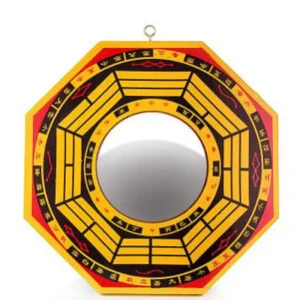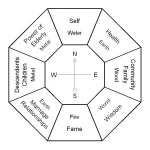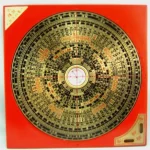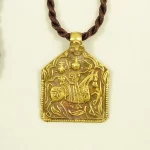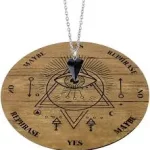Pa Kua, cunoscut și sub numele de Bagua (sau Baguazhang), este un concept străvechi de arte filozofice și marțiale chinezești, adânc înrădăcinat în filosofia taoistă.
Termenul „Pa Kua” se traduce prin „opt trigrame” (Qian, Kun, Zhen, Xun, Kan, Li, Gen, Dui), simbolizând principiile fundamentale care sunt esențiale pentru înțelegerea universului, existenței și artelor marțiale.
Pa Kua întruchipează principiile armoniei, echilibrului și interconexiunii contrariilor – constă din opt trigrame, fiecare compusă din trei linii, iar aceste combinații de linii solide și întrerupte sunt folosite pentru a ilustra dinamica și interacțiunea energiilor cosmice.
Originar din filozofia și cosmologia antică chineză, Bagua este o reprezentare simbolică a principiilor fundamentale care stau la baza lumii naturale, a existenței umane și a universului.
Bagua este un concept fundamental în taoism, confucianism, feng shui și medicina tradițională chineză.
Dispunerea trigramelor în diagrama Bagua va ajuta la ilustrarea reprezentării simbolice a energiilor cosmice și a principiilor fundamentale din cosmologia chineză.
Origini și semnificație
- Bagua își găsește rădăcinile în textul chinez antic, „I Ching” sau „Yijing”, care este un clasic filozofic și divinație.
- „Ba” înseamnă opt, iar „gua” înseamnă trigramă, prin urmare Bagua se referă la cele opt trigrame.
Cele opt trigrame
Fiecare trigramă este alcătuită din trei linii, fie solide (yang) fie întrerupte (yin), reprezentând diferite combinații de yin și yang, dualitățile fundamentale în filosofia chineză.
Trigramele sunt numite: Qian (Rai), Kun (Pământ), Zhen (Tunet), Xun (Vânt), Kan (Apă), Li (Foc), Gen (Munte) și Dui (Lac).
Interpretări și simbolism
Trigramele simbolizează diverse aspecte ale vieții, elemente naturale, anotimpuri, direcții și relații de familie.
De exemplu, Raiul (Qian) reprezintă puterea și creativitatea, în timp ce Pământul (Kun) simbolizează receptivitatea și îngrijirea.
Aranjarea în diagrama Bagua Trigramele sunt aranjate într-o diagramă octogonală, formând o reprezentare simbolică a principiilor fundamentale ale realității și a naturii ciclice a schimbării.
Fiecare trigramă este poziționată în raport cu direcțiile cardinale și ordinale.
Utilizare în Feng Shui
Bagua este un instrument esențial în feng shui, un vechi sistem chinezesc care armonizează indivizii cu mediul lor pentru a promova echilibrul, prosperitatea și bunăstarea.
În feng shui, Bagua este suprapus peste un plan de etaj sau o cameră pentru a determina calitățile energetice asociate fiecărei secțiuni.
Aplicații filozofice și practice
Bagua servește ca instrument de auto-reflecție, ajutând indivizii să înțeleagă energiile din interiorul și din jurul lor și cum să se armonizeze cu aceste energii.
Este, de asemenea, folosit în medicina tradițională chineză pentru a înțelege relațiile dintre diferite organe, meridiane și funcții ale corpului.
Concepte filozofice și marțiale
Yin și Yang – Pa Kua subliniază interacțiunea dintre Yin și Yang, forțe opuse, dar complementare. Yin reprezintă aspectele receptiv, cedator și pasiv, în timp ce Yang reprezintă aspectele active, asertive și dinamice. Echilibrul dintre Yin și Yang este esențial pentru practica artelor marțiale și viața în general.
Circularitate și continuitate – Natura circulară a Bagua simbolizează schimbarea continuă, ciclurile vieții și natura permanentă a existenței. Practicanții învață să se adapteze, să se miște fără probleme și să rămână flexibili ca apa.
Practica artelor marțiale
- Pa Kua Zhang
- Pa Kua Zhang este o artă marțială care folosește mișcări circulare și tehnici evazive; practicanții se antrenează să se miște într-o manieră curgătoare, în spirală, valorificând circularitatea și agilitatea simbolizate de Bagua.
- Strategia de luptă
- Pa Kua pune accent pe redirecționarea și evitarea atacurilor, folosind energia unui adversar împotriva lor. Practicanții își propun să mențină o poziție centrată și să folosească un joc agil de picioare pentru a manevra în jurul adversarilor.
Sănătate și bunăstare holistică
Dincolo de artele marțiale, Pa Kua este adesea practicată pentru beneficiile sale pentru sănătate, punând accent pe bunăstarea holistică, reducerea stresului, flexibilitatea sporită și fluxul de energie îmbunătățit în interiorul corpului.
Exerciții precum cele opt palme ale lui Ba Gua sunt concepute pentru a promova sănătatea fizică, mentală și spirituală.
Interpretări moderne
Bagua și trigramele sale continuă să influențeze diverse domenii, inclusiv psihologia, artele marțiale și managementul afacerilor, adaptându-se la contextele moderne, păstrându-și în același timp principiile fundamentale.
Bagua, cu trigramele și simbolismul său bogat, servește ca un cadru filozofic profund pentru înțelegerea dinamicii universului și a interconexiunii tuturor lucrurilor.
Rămâne un concept semnificativ în cultura chineză, oferind perspective asupra vieții armonioase, a mediilor echilibrate și a principiilor atemporale care ne ghidează viața.

